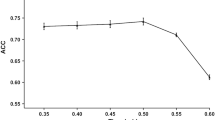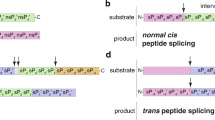Abstract
The proteasome complex is mainly responsible for proteolytic degradation of cytosolic proteins, generating the C-terminus of MHC I-restricted peptide ligands and CD8 T cell epitopes. Therefore, prediction of proteasomal cleavage sites is relevant for anticipating CD8 T-cell epitopes. There are two different proteasomes, the constitutive proteasome, expressed in all types of cells, and the immunoproteasome, constitutively expressed in dendritic cells. Although both proteasome forms generate peptides for presentation by MHC I molecules, the immunoproteasome is the main form involved in providing peptide fragments for priming CD8 T cells. On the contrary, the proteasome provides peptides for presentation by MHC I molecules that can be targeted by already primed CD8 T cells. Proteasome cleavage prediction server (PCPS) is a server for predicting cleavage sites generated by both the constitutive proteasome and the immunoproteasome. Here, we illustrate the usage of PCPS to predict proteasome and immunoproteasome cleavage sites and compare the results with those provided by NetChop, a related tool available online. PCPS is implemented for free public use available online at http://imed.med.ucm.es/Tools/pcps/.
Access this chapter
Tax calculation will be finalised at checkout
Purchases are for personal use only
Similar content being viewed by others
References
Kloetzel PM (2001) Antigen processing by the proteasome. Nat Rev Mol Cell Biol 2(3):179–187
Blum JS, Wearsch PA, Cresswell P (2013) Pathways of antigen processing. Annu Rev Immunol 31:443–473
Rock KL, Goldberg AL (1999) Degradation of cell proteins and the generation of MHC class I-presented peptides. Annu Rev Immunol 17:739–779
Craiu A, Akopian T, Goldberg A, Rock KL (1997) Two distinct proteolytic processes in the generation of a major histocompatibility complex class I-presented peptide. Proc Natl Acad Sci U S A 94(20):10850–10855
Dalet A, Stroobant V, Vigneron N, Van den Eynde BJ (2011) Differences in the production of spliced antigenic peptides by the standard proteasome and the immunoproteasome. Eur J Immunol 41(1):39–46
Morel S, Levy F, Burlet-Schiltz O, Brasseur F, Probst-Kepper M, Peitrequin AL et al (2000) Processing of some antigens by the standard proteasome but not by the immunoproteasome results in poor presentation by dendritic cells. Immunity 12(1):107–117
Nielsen M, Lundegaard C, Lund O, Kesmir C (2005) The role of the proteasome in generating cytotoxic T-cell epitopes: insights obtained from improved predictions of proteasomal cleavage. Immunogenetics 57(1–2):33–41
Rivett AJ, Hearn AR (2004) Proteasome function in antigen presentation: immunoproteasome complexes, peptide production, and interactions with viral proteins. Curr Protein Pept Sci 5(3):153–161
Nussbaum AK, Kuttler C, Hadeler KP, Rammensee HG, Schild H (2001) PAProC: a prediction algorithm for proteasomal cleavages available on the WWW. Immunogenetics 53(2):87–94
Tenzer S, Peters B, Bulik S, Schoor O, Lemmel C, Schatz MM et al (2005) Modeling the MHC class I pathway by combining predictions of proteasomal cleavage, TAP transport and MHC class I binding. Cell Mol Life Sci 62(9):1025–1037
Holzhutter HG, Frommel C (1999) Kloetzel PM. A theoretical approach towards the identification of cleavage-determining amino acid motifs of the 20 S proteasome. J Mol Biol 286(4):1251–1265
Kuttler C, Nussbaum AK, Dick TP, Rammensee HG, Schild H, Hadeler KP (2000) An algorithm for the prediction of proteasomal cleavages. J Mol Biol 298(3):417–429
Bhasin M, Raghava GP (2005) Pcleavage: an SVM based method for prediction of constitutive proteasome and immunoproteasome cleavage sites in antigenic sequences. Nucleic Acids Res 33(Web Server issue):W202–W207
Saxova P, Buus S, Brunak S, Kesmir C (2003) Predicting proteasomal cleavage sites: a comparison of available methods. Int Immunol 15(7):781–787
Kesmir C, Nussbaum AK, Schild H, Detours V, Brunak S (2002) Prediction of proteasome cleavage motifs by neural networks. Protein Eng 15(4):287–296
Diez-Rivero CM, Lafuente EM, Reche PA (2010) Computational analysis and modeling of cleavage by the immunoproteasome and the constitutive proteasome. BMC Bioinformatics 11:479
Fleri W, Paul S, Dhanda SK, Mahajan S, Xu X, Peters B et al (2017) The immune epitope database and analysis resource in epitope discovery and synthetic vaccine design. Front Immunol 8:278
Reche PA, Glutting JP, Zhang H, Reinherz EL (2004) Enhancement to the RANKPEP resource for the prediction of peptide binding to MHC molecules using profiles. Immunogenetics 56(6):405–419
Reche PA, Glutting JP, Reinherz EL (2002) Prediction of MHC class I binding peptides using profile motifs. Hum Immunol 63(9):701–709
Acknowledgments
We wish to thank the Spanish department of science at MINECO for supporting the research of the immunomedicine group through grants SAF2006:07879, SAF2009:08301 and BIO2014:54164-R to P.A.R.
Author information
Authors and Affiliations
Corresponding author
Editor information
Editors and Affiliations
Rights and permissions
Copyright information
© 2020 Springer Science+Business Media, LLC, part of Springer Nature
About this protocol
Cite this protocol
Gomez-Perosanz, M., Ras-Carmona, A., Reche, P.A. (2020). PCPS: A Web Server to Predict Proteasomal Cleavage Sites. In: Tomar, N. (eds) Immunoinformatics. Methods in Molecular Biology, vol 2131. Humana, New York, NY. https://doi.org/10.1007/978-1-0716-0389-5_23
Download citation
DOI: https://doi.org/10.1007/978-1-0716-0389-5_23
Published:
Publisher Name: Humana, New York, NY
Print ISBN: 978-1-0716-0388-8
Online ISBN: 978-1-0716-0389-5
eBook Packages: Springer Protocols




